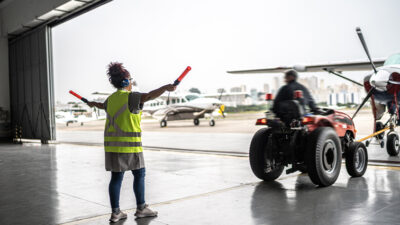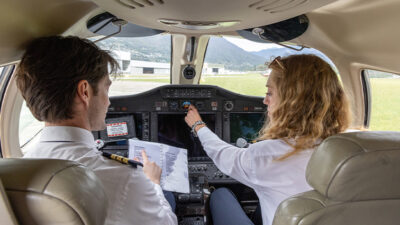Safety Reporting: Crewed and Un-Crewed

It’s an exciting time to be part of the expanding UAS industry. It has been a whirlwind to watch the growth from its earliest days until now.
Over the next few years, it will continue that evolution and expand in tandem with regulatory standards and guidelines for its safe operation. Operators can expect guidelines and regulations for Part 107 operators to be set and revised with data from many sources, including NASA’s Aviation Safety Reporting System (ASRS).
ASRS and UAS Incidents
In a nutshell, ASRS confidentially collects, analyzes and reports on voluntarily submitted aviation safety incidents. The reports describe unsafe occurrences, hazardous situations and lessons learned in an effort to prevent others from making the same mistakes. With the expansion of the UAS industry, NASA has added the ability for separate UAS safety reporting.
You can be a part of submitting data to make the nation’s airspace safer. Additional UAS reports will help build the data and provide real-world information as regulations are developed. UAS operators are encouraged to submit to this voluntary and confidential safety data collection tool.
In exchange for filing an ASRS report, the FAA offers protection against civil penalty and certificate suspension. Keep in mind, reports regarding accidents and criminal acts such as reckless endangerment, criminal mischief or voyeurism are excluded from the protections offered by the FAA.
A report to ASRS may be filed at any time, but to receive protection from the FAA (from penalties or certificate suspension), a report must be submitted within 10 days of the event, or when the operator first became aware of the event. Reports may be submitted online, or a paper form is available on the NASA ASRS website. Details and specifics are available from the FAA Advisory Circular (AC) 00-46F and NASA ASRS.
Confidential Incident Reporting
ASRS de-identifies reports before entering them into the publicly available ASRS database. All personal and organization names are removed, protecting confidentiality of reporters and their companies. Dates, times, aircraft make/model and related information, which could be used to infer an identity, are either generalized or eliminated.
The ASRS reporting process is designed to be constructive and assist in preventing future violations. Submissions to ASRS are regarded as one of the world’s largest sources of data on aviation safety and human factors. These reports help improve the safety in the National Airspace System (NAS) and can identify the safest ways to integrate UAS into the NAS.
The reporting system helps answer questions as to why a system failed or a human erred. ASRS has been a part of the aviation safety culture for more than 45 years and has logged more than 1.8 million safety reports.
The success of the ASRS reporting model has been applied to other industries including railroad, medical, security, firefighting, maritime and law enforcement. Across the aviation industry, submissions are routinely and confidentially submitted by pilots, air traffic controllers, cabin crew, dispatchers, maintenance technicians, ground personnel and others involved in professional and recreational operations.
The time is now for UAS operators to embrace the UAS ASRS reporting mechanism and contribute to the body of knowledge for the UAS industry.
For UAS operations, anyone can file a confidential NASA ASRS report: Part 107 crews, Part 135 operators, public operators, recreational flyers and visual observers.
Users of the Baldwin Safety Management System can submit information directly to ASRS. This new integration is being incorporated into Baldwin’s Aviation Safety Action Program (ASAP). If a Baldwin user decides to file an ASRS report, the required information is sent via ASAP, eliminating the need to complete a separate report.
Through research and analysis of reports, ASRS can share:
- Lessons learned, which can help prevent others from making the same mistake
- Best practices for procedures, checklists and safety briefings to support safe UAS operations
- Information on equipment, software and automation issues that can contribute to UAS incidents
- Assistance in resolving UAS issues to improve safety
The expanding use of UAS ASRS reporting in the airspace makes submitting reports important and significant.
How Submitted Information Is Used
ASRS takes the information it receives, interprets the data and produces products and services to promote aviation safety. These include:
- Alert Messages – Safety information is sent to organizations in positions of authority so they can evaluate it and take possible corrective actions.
- Quick Responses – Rapid turnaround data analysis is typically accomplished within 2 to 10 business days of request. These responses are generally limited to government agencies such as FAA, DOT, NTSB, NASA and the U.S. Congress. (144 through Dec. 2020).
- Search Requests – Information in the ASRS Database is available publicly. Members of the aviation community may submit a search request to the ASRS to receive a relevant report. Direct access is also available to search de-identified reports in the ASRS database at https://asrs.arc.nasa.gov/search/database.html (7.5K through Dec. 2020).
- Monthly newsletter – CALLBACK presents timely and relevant report excerpts. All issues since December 1994 are available for download at the ASRS website at: https://asrs.arc.nasa.gov/publications/callback.html (more than 32K subscribers).
- Focused Studies/Research – There have been 64 research studies published covering topics such as operations, human factors and confidential reporting.
Resources and Links
UAS webpage: https://asrs.arc.nasa.gov/uassafety.html
ASRS Program: https://asrs.arc.nasa.gov/overview/summary.html
Lots of great info and graphs in here https://asrs.arc.nasa.gov/docs/ASRS_ProgramBriefing.pdf
 Baldwin Safety & Compliance
Baldwin Safety & ComplianceCustomized Safety Management programs developed by experienced and credentialed safety professionals include training, manual management and SMS implementation/software. Based on ICAO and other international standards and regulations, Baldwin’s programs support Business Aviation, Charter, FBO, Airport, Medical Transport and Regional Airlines by providing advanced software, an outstanding customer experience and our Commitment to Excellence.
http://www.baldwinaviation.com/
© 2024 Baldwin Safety & Compliance. All Rights Reserved.
Next ArticleRelated Posts

The Effects of a Learning Mindset on Safety Culture
As aviation departments strive to enhance their safety performance, a critical yet often overlooked element is the need to foster a learning-culture mindset. This mindset shift can unlock invaluable opportunities for continuous improvement, employee engagement and creating a resilient safety environment. From a behavioral management perspective, as your company’s learning culture goes, so goes the ongoing success of your SMS.

Safety in Numbers: Trends in Aviation Accidents and Incidents
Every accident is preventable; the problem is that we don’t know how to prevent it until after the accident happens. However, what we can do as an industry is honor the anguish of each event by sharing the information, the mistakes and the outcomes to improve safety for everyone.

